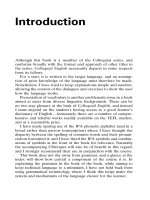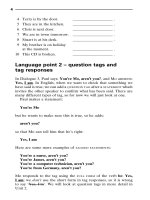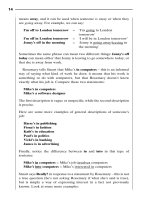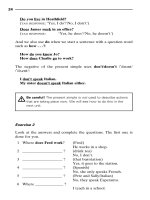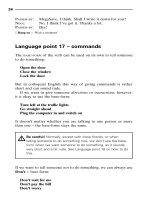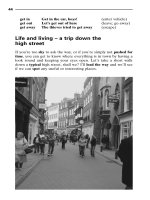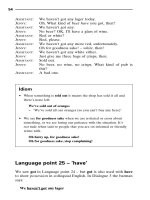ENGLISH PRACTICAL COURSE second year course 1 pdf
Bạn đang xem bản rút gọn của tài liệu. Xem và tải ngay bản đầy đủ của tài liệu tại đây (685.94 KB, 180 trang )
DOMNICA ŞERBAN
DENISA DR GUŞIN
ENGLISH PRACTICAL COURSE
FOR SECOND YEAR STUDENTS
Coperta: Gustav Klimt – Lebensbaum (1909)
Referent ştiin ific: lector univ. M d lina Crivoi
© Editura Funda iei România de Mâine, 2007
Editur acreditat de Ministerul Educa iei şi Cercet rii
prin Consiliul Na ional al Cercet rii Ştiin ifice
din Înv mântul Superior
Descrierea CIP a Bibliotecii Na ionale a României
ŞERBAN, DOMNICA
English practical course for second year students/
Domnica Şerban, Denisa Dr guşin. – Bucureşti:
Editura Funda iei România de Mâine, 2007.
ISBN 978-973-725-943-1
I. Dr guşin, Denisa
811.111(075.8)
Reproducerea integral sau fragmentar , prin orice form
şi prin orice mijloace tehnice, este strict interzis
şi se pedepseşte conform legii.
R spunderea pentru con inutul şi originalitatea textului
revine exclusiv autorului/autorilor.
Redactor: Andreea DINU
Tehnoredactor: Brînduşa B RBAT
Coperta: Cornelia PRODAN
Bun de tipar: 26.10.2007; Coli de tipar: 11,25
Format: 16/61X86
Editura Funda iei România de Mâine
Bulevardul Timişoara nr. 58, Bucureşti, sector 6
Tel / Fax: 021/444.20.91; www.spiruharet.ro
e-mail:
UNIVERSITATEA SPIRU HARET
FACULTATEA DE LIMBI ŞI LITERATURI STR INE
DOMNICA ŞERBAN
DENISA DR GUŞIN
ENGLISH PRACTICAL COURSE
FOR SECOND YEAR STUDENTS
EDITURA FUNDA IEI ROMÂNIA DE MÂINE
Bucureşti, 2007
CONTENTS
Preface …………………………………………………………………
9
Part I (The First Term)
Introduction …………………………………………………………….
15
UNIT 1: EDUCATING MAN: GOING TO SCHOOL;
READING BOOKS
A. Pilot Text: The Flight from the Enchanter ………………………….
I. Reading Comprehension ……………………………………….
II. Lexical Focus ………………………………………………….
III. Vocabulary Practice …………………………………………...
IV. Grammar Practice …………………………………….……….
V. Translation …………………………………………………….
VI. Conversation ………………………………………….……….
VII. Composition …………………………………………………..
B. Satellite text …………………………………………………….…..
I. Reading …………………………………………………………
II. Comprehension Check-up ………………………………….….
III. Translation …………………………………………….……….
IV. Building Vocabulary ………………………………….……….
V. Conversation …………………………………………………...
VI. Composition ……………………………………………………
18
20
20
21
22
25
26
26
27
27
30
30
30
31
31
UNIT 2: PHYSICAL AND EMOTIONAL LIFE (1): LIFE
AND DEATH; THE HUMAN BODY; RELATIONS
AND FEELINGS
A. Pilot text: A Single Man …………………………………………….
I. Reading Comprehension ……………………………………….
II. Lexical Focus …………………………………………….……
32
35
35
5
III. Vocabulary Practice ……………………………………………
IV. Grammar Practice …………………………………….………..
V. Translation ………………………………………………….…
VI. Conversation ……………………………………….………….
VII. Composition ………………………………………….……….
B. Satellite text …………………………………………………….…...
I. Reading …………………………………………………………
II. Comprehension Check-up ……………………………………...
III. Translation …………………………………………….……….
IV. Building Vocabulary ………………………………….………..
V. Conversation …………………………………………………...
VI. Composition ……………………………………………………
36
37
39
40
41
41
41
44
44
45
48
48
UNIT 3: PHYSICAL AND EMOTIONAL LIFE (2): INTER-HUMAN
RELATIONSHIPS; LOVE AND MARRIAGE
A. Pilot text: The Betrayed Kingdom …………………………………..
I. Reading Comprehension ……………………………………….
II. Lexical Focus ………………………………………………….
III. Vocabulary Practice …………………………………………...
IV. Grammar Practice …………………………………….……….
V. Translation …………………………………………………….
VI. Conversation ………………………………………….……….
VII. Composition ………………………………………….……….
B. Satellite text …………………………………………………….…..
I. Reading …………………………………………………………
II. Comprehension Check-up ……………………………………..
III. Translation …………………………………………….……….
IV. Building Vocabulary ………………………………….………..
V. Conversation …………………………………………………...
VI. Composition ……………………………………………………
Revision Test I …………………………………………………….…...
49
51
51
52
53
55
56
56
56
56
61
62
62
63
63
64
Part II (The Second Term)
Introduction …………………………………………………………….
71
UNIT 4: LIFE AND TECHNOLOGY
A. Pilot text: Computers will know us Better than We Know Ourselves ….
I. Reading Comprehension ……………………………………….
6
73
75
II. Lexical Focus ……………………………………………….….
III. Vocabulary Practice ……………………………………………
IV. Grammar Practice …………………………………….………..
V. Translation ………………………………………………….…
VI. Conversation ……………………………………….………….
VII. Composition ………………………………………….……….
B. Satellite text …………………………………………………….…...
I. Reading …………………………………………………………..
II. Comprehension Check-up ………………………………………
III. Translation …………………………………………….……….
IV. Building Vocabulary ………………………………….………..
V. Conversation ……………………………………………………
VI. Composition ……………………………………………………
75
75
76
78
80
80
81
81
84
84
84
86
86
UNIT 5: MAN AS ARTIST
A. Pilot text: The Listener ……………………………………………... 87
I. Reading Comprehension ………………………………………. 90
II. Lexical Focus ……………………………………………….…. 90
III. Vocabulary Practice …………………………………………… 91
IV. Grammar Practice …………………………………….……….. 91
V. Translation ………………………………………………….… 94
VI. Conversation ……………………………………….…………. 94
VII. Composition ………………………………………….………. 95
B. Satellite text …………………………………………………….…... 95
I. Reading ………………………………………………………… 95
II. Comprehension Check-up ……………………………………... 99
III. Translation …………………………………………………….. 99
IV. Building Vocabulary ………………………………………….. 99
V. Conversation ……………………………………….……….…. 102
VI. Composition …………………………………………………… 102
UNIT 6: MAN IN THE MIDST OF NATURE
A. Pilot text: Reflections on the Death of a Porcupine ………………...
I.1. Reading Comprehension ………………………………………
I.2. Further Text Discussion ……………………………………….
II. Lexical Focus ……………………………………………….…
III. Vocabulary Practice ……………………………………………
IV. Grammar Practice ……………………………………………...
103
106
106
107
107
108
7
V. Translation ……………………………………………….……
VI. Conversation ……………………………………………….….
VII. Composition …………………………………………………..
B. Satellite text 1..………………………………………………………
I. Reading …………………………………………………………
II. Comprehension Check-up and Text Discussion …………….…
III. Translation ……………………………………………………..
IV. Building Vocabulary …………………………………………..
V. Conversation ……………………………………….……….….
VI. Composition ……………………………………………………
C. Satellite text 2..………………………………………………………
I. Reading …………………………………………………………
II. Comprehension Check-up ……………………………………...
III. Translation ……………………………………………………..
IV. Building Vocabulary …………………………………………...
V. Conversation ……………………………………….……….….
VI. Composition ……………………………………………………
110
111
111
111
111
114
114
115
115
115
115
115
120
120
120
121
121
Revision Test II …………………………………………………….…. 122
Instead of a Key ………………………………………………………. 126
Appendix – Grammar Synopses ……………………………………… 137
– Composition Writing Synopses ………………………... 173
Bibliography ………………………………………………………….. 179
8
PREFACE
The English Practical Course is designed to help the second year
students reach and consolidate the upper-intermediate level of English.
It is a skill-based approach, tackling abilities like: reading, writing,
speaking, listening and also, handling grammatical structures.
The course aims at securing an important progress in the domain
of vocabulary and syntactic patterns (at the level of phrases, simple
sentences and complex sentences), the acquisition of which should
allow the students to efficiently apply their knowledge in various
discourse contexts and in a wide range of textual genres. The language
chosen as main variety is Standard General English; besides we also
introduce the basic core of English for Academic Purposes, as well as
the minimal specialized vocabulary of English for Scientific and
Technical Purposes and of English for Arts, with particular focus on
musical terms.
Our material consolidates the upper-intermediate level of English
by covering various other lexical areas. The students’ grammatical
awareness will be enhanced by applications focused on syntactic
structures at phrase, simple sentence and compound or complex
sentence types.
The students’ competence in the realm of the four skills will be
refined by means of complex practical activities including discourse
analysis, comprehension checks, reading by skimming and scanning,
talking about controversial topics or writing on given or relatively free
topics.
By the end of the academic year the students will have acquired
the necessary competence in translating fictional and non-fictional
texts into and from the target language, in essay writing, and in
conversing on topics related to the selected text samples.
The present English Practical Course consists of five thematically
oriented units (Educating Man, Physical and Emotional Life, Life and
9
Technology, Man as Artist, Man in the Midst of Nature) developed in
six units, three per term.
Each unit is made up of two parts: part A, focusing on the
selected pilot text, mainly conveying the respective topic, and part B,
focusing on the satellite text which is kindred with the pilot one from
a thematic point of view. The latter helps the student go deeper into
the already introduced subject matter; besides it provides further
reading material opening new perspectives.
Every pilot text is followed by reading comprehension, vocabulary
practice and grammar practical activities and exercises, all designed so
as to consolidate both the semantic and syntactic knowledge stored by
the students. Part A also includes a translation section, testing the
students’ ability to translate from the native language into the target
one, as well as a conversation section, aiming at improving the
students’ speaking competence.
The last section is focused on composition aiming at developing
the students’ writing skills, their creativeness.
The second part of the unit, part B, reinforces the topic
announced in part A, being built on the following sub-sections: the
text reading section, introducing the satellite text; the comprehension
check-up section, made up of a set of questions testing the students’
understanding of the text; the translation section, assessing the
students’ ability to translate from the target language into the native
one; the building vocabulary section providing the students with
vocabulary lists of the respective domain; the conversation and the
composition sections consolidating and refining the students’ speaking
and writing skills.
Two revision tests round off each of the two parts. Their role is
to check the lexical and the grammatical cognitive material introduced
in the respective units.
At the end of the book, in the appendix, there are several
grammar and composition synopses meant to function as working
instruments, which will help the students’ solve their tasks more
efficiently. These materials also facilitate exam preparation, by the
systematic picture they provide. Linguistic awareness in the domains
of grammar and discourse will also be consolidated if these synopses
are assimilated by the second year student.
We would like to conclude by referring back to the essential
components of our corpus, i.e. the texts we have selected as starting or
10
final points of each section. Our choice has been deliberately oriented
towards fictional discourse as prior and non-fictional discourse,
mainly media texts, as secondary. We would like to motivate our
option, by stating most openly that in our capacity as discourse
analysts we consider, alongside many others discourse specialists that
reading a fictional piece of work is tantamount to a new cognitive
experience. This experience is actually more striking from a cognitive
point of view than a real world experience, since, in most cases it
triggers the refreshment or even the building of new mental schemata.
Hence, the greater emotional involvement of the students who thus
penetrate a captivating possible world in the realm of the imagination.
Imaginary worlds activate a richer vocabulary and a very diverse use
of language structures.
We also believe that students have to be confronted with
informative factual discourse, as used daily in the media.
The resulting effect should be an alternation of perspectives, real
and imaginary, hopefully challenging the students’ intellect and thus
supplying a fertile ground for the acquisition of a rich lexicon and a
variety of linguistic patterns.
This book should be, therefore, not only a teaching tool, but also
a source of intellectual pleasure.
The authors
11
12
PART I
(The First Term)
13
14
INTRODUCTION
The major theme approached in the first semester is “the human
universe” including topics related to the human being, viewed in both
physical and spiritual terms. The two sub-topics are Educating Man
(one pilot text) and Physical and Emotional Life (two pilot texts).
The unit is divided in two major parts: A and B, each having a
set of sub-sections structured as follows:
PART A (FOCUSED ON THE PILOT TEXT):
• The Text Section has a complex structure containing a pilot
text, thematically oriented and a text analysis and vocabulary practice
activities. The pilot texts for the first semester are: The Flight from the
Enchanter by Iris Murdoch; A Single Man by Cristopher Isherwood;
The Betrayed Kingdom by Richard Brautigan; The wide variety of
applications (activities and exercises) helps the students increase their
vocabulary, and improve their reading and speaking skills.
• The Grammar Section deals with applied Syntax topics. In
the first semester the following issues are to be studied: sentence types
with respect to word order peculiarities and communicative functions;
uses of be, copula-like verbs, basic and derived predicatives, structures
with predicative adjuncts; monotransitives and ditransitives, the
cognate object, prop-verbs, causatives and ergatives, reflexive and
reciprocal transitives, transitive phrasal verbs; complex intransitive
verbs. Each issue is allocated a range of activities meant to revise and
go thoroughly into the main grammar structures.
• The Translation Section contains a corpus of texts focusing
on the grammatical and lexical problems approached. The texts are
chosen from contemporary Romanian prose. Syntactic and stylistic
adequacy are checked.
• The Conversation Section consists of three or four topics of
discussion thematically linked with the pilot text.
15
• The Composition Section consists of two essays per unit
(one of which is obligatory) on topics related to the pilot text.
• Self-Evaluation by Revision tests
PART B (FOCUSED ON THE SATELLITE TEXT):
• The Reading Section is meant to provide students with
further reading materials in the topic field announced in part A. The
satellite texts for the first term are: Total Effect and the Eighth Grade
by Flannery O’Connor, In Bed by Joan Didion, Manners, Customs,
and Observances: Their Origin and Significance by Leopold Wagner.
• The Comprehension Check-up Section is designed to see
whether students can get the gist of the prose – its underlying purpose
and principal ideas – quickly and accurately.
• The Translation Section points to the entire satellite text,
practising the students’ ability to render the syntactic and semantic
structures of the respective text from the target language into the
native language.
• The Building Vocabulary Section introduces students to
various lists of words topic related, thus, increasing the students’
knowledge of the respective domain.
• The Conversation Section consists of three or four topics of
discussion thematically related to the satellite text.
• The Composition Section consists of two essays per unit
(one of which is obligatory) on topics related to the satellite text.
16
UNIT 1
EDUCATING MAN: GOING TO SCHOOL;
READING BOOKS
Dame Jean Iris Murdoch (July 15, 1919 – February 8, 1999),
born in Dublin, Ireland, is known primarily as a novelist, but also as a
fine philosopher. Her first published novel, Under the Net (1954), was
selected by the editorial board of the American Modern Library in
2001 as one of the 100 best English novels of the 20th century. She
produced twenty five novels throughout her prolific career as a writer.
Besides she wrote quite a few original essays on philosophical issues.
All her works prove a high professionalism and a deep insight into the
human nature.
In 1987, she was made a Dame Commander of the Order of the
British Empire.
While still in her sixties, Iris Murdoch visited Romania, being
accompanied by her husband John Bayly, a novelist and a university
professor of English literature. She delivered a brilliant lecture on the
relation between art and philosophy to the then students of English in
Bucharest. The lecture was followed by the novelist’s exciting
discussions with the students and teaching staff at the Bucharest
University Department of English in Bucharest.
Iris Murdoch was stricken by Alzheimer’s disease, from which
she began to suffer in 1995. She was most devotedly taken care of by
her husband. The bitter years of mental disorder in the context of the
couple’s tender love have been made into an unforgettable movie,
IRIS, a shocking biopic directed by Richard Eyre. Kate Winslet
portrayed young Iris, Judy Dench created the image of the old writer.
The excerpt below has been selected from her second novel The
Flight from the Enchanter (1956). The text is highly relevant for
topics like: the psychology of teenagers in the context of secondary
school, the power relations holding between the authority as represented
by teachers and the pupils they are trying to train, the child’s drive to
break free from the school environment.
17
A. PILOT TEXT: THE FLIGHT FROM THE ENCHANTER
(by Iris Murdoch – a fragment)
Annette put her coat on and was ready to go. But now when she
reached the door that led into the street she paused suddenly. She
turned around and looked along the corridor. Everything seemed the
same; the expensive flora, the watery reproductions of famous
paintings, the much admired curve of the white staircase. Annette
stared at it all. It looked to her the same, and yet different. It was as if
she had walked through the looking-glass. She realized that she was
free. As Annette pondered, almost with awe, upon the ease with which
she had done it, she felt that Ringenhall had taught her its most
important lesson. She began to walk back, peering through doorways
and touching objects with her fingers. She half expected to find new
rooms hidden behind familiar doors. She wandered into the library.
She entered quietly and found that as usual the room was empty.
She stood there in the silence until it began to look to her like a library
in a sacked city. No one owned these books now. No one would come
here again; only after a while the wall would crumble down and the
rain would come blowing in. It occurred to Annette that she might as
well take away one or two books as souvenirs. Volumes were not
arranged in any particular order, not were they stamped or catalogued.
She examined several shelves. The books were chaotic, but in mint
condition, since reading was not a popular activity at Ringenhall. At
length she selected a leather-bound copy of the Collected Poems of
Browning, and left the room with the book under her arm. She was by
now feeling so happy that she would have shouted for joy if it had not
been for the delicious spell which she felt herself to be under and
which still enjoined silence. She looked about her complacently.
Ringenhall was at her mercy.
There were two things which Annette had wanted to do ever
since she had arrived. One of these was to carve her name on a
wooden bust by Grinling Gibbons, which stood in the common-room.
There was something solemn and florid about this work, which made
Annette itch for a blade. The wood was soft and inviting. However,
she rejected this idea, not because the name of Grinling Gibbons
carried, when it came to it, any magic for her, but because she had
mislaid her pocket-knife. The other thing which she had always
wanted to do was to swing on the chandelier in the dining-room. She
18
turned rapidly in the direction of that room and bounded in. Tables
and chairs stood by, silent with disapproval. Annette looked up at the
chandelier and her heart beat violently. The thing seemed enormously
high up and far away. It hung from a stout chain; Annette had noticed
this carefully when she had studied it in the past. She had also
remarked a strong metal bar, right in the centre of it, on which she had
always planned to put her hands. All about and above this bar were
suspended tiny drops of crystal, each one glowing with a drop of pure
light tinier still, as if a beautiful wave had been arrested in the act of
breaking while the sun was shining upon it. Annette had felt sure that
if she could swing upon the chandelier the music which was hidden in
the crystals would break out into a great peal of bells. But now it
seemed to be very hard to get at.
In her imagination Annette had always reached the objective by
a flying leap from the High Table; but she could see now that this was
not a practical idea. Grimly she began to pull one of the tables into the
centre of the room. On top of the table she placed one of the chairs.
Then she began to climb up. By the time she was on the table she was
already beginning to feel rather far away from the ground. Annette
was afraid of heights. However, she mounted resolutely on to the
chair. Here, by standing on tiptoe, she could get her hands over the
metal bar. She paused breathlessly. Then with a quick movement she
kicked the chair away and hung stiffly in mid-air. The chandelier felt
firm, her grip was strong, there was no terrible rending sound as the
chain parted company with the ceiling. “After all”, thought Annette, “I
don’t weigh much”.
She kept her feet neatly together and her toes pointed. Then with
an oscillation from the hips she began to swing very gently to and fro.
The chandelier began to ring, not with a deafening peal but with a
very high and sweet tinkling sound; the sort of sound, after all, which
you would expect a wave of the sea to make if it had been
immobilized and turned into glass: a tiny internal rippling, a mixture
of sound and light. Annette was completely enchanted by this noise
and by the quiet rhythm of her own movements. She fell into a sort of
trance, and as she swung dreamily to and fro she had a vision of
remaining there for the rest of the afternoon until the boarders of
Ringenhall, streaming in for their dinner, would make their way round
on either side of her swinging feet and sit down, paying her no more
attention than if she had been a piece of furniture.
19
At that moment the door opened and Miss Walpole came in.
Annette, who was at the end of one of her swings, let go abruptly of
the chandelier and, missing the table, fell to the floor with a crash at
Miss Walpole’s feet. Miss Walpole looked down at her with a slight
frown. This lady was never sure which she disliked most, adolescent
girls or small children; the latter made more noise, it was true, but they
were often in the long run easier to handle.
*
APPLICATIONS
I. Reading Comprehension
• What would you feel when entering such a corridor and
library?
• What is the ‘important lesson’ Annette has been taught?
• What sort of person would do the two things Annette wanted
to do?
• How do you perceive her attitude to the school?
• Does the fact that she carries one of them out say anything
about her character?
II. Lexical Focus
• Look up the following words and phrases in a dictionary:
Verbs
to ponder
to peer
to itch
to bound
to glow
to arrest
Nouns
awe
leap
peal (a ~ of bells)
ripple
grip
height
Adjectives/Adverbs
complacent(ly)
violent(ly)
breathless(y)
high up
far away
resolute(ly)
Prep. Phrases
at length
at one’s mercy
on tiptoe
in the past
on to the chair
with a frown
• Use the items from the prepositional phrases column in
contexts of your own.
20
III. Vocabulary Practice
1. Collocate the adjectives below with possible noun heads so as to
illustrate their range of meanings (i.e. their polysemy):
wooden; watery; neat; grim; stiff; soft
2. Fill in with a verb indicating cutting and complete the list of
synonyms by further items, such as: carve, trim, clip, hew etc.
a) In spring we always ............ our trees.
b) Let’s ............ this interesting article!
c) Her hair is ......... .
d) You’d better ............. this meat rather than ............ it.
e) An unknown artist has ................... the statue of the Happy
Prince.
f) A lot of animals have been ............ for food products.
g) We had to .......... our way through the thick jungle.
3. Supply six items (minimally) in the series of synonyms:
a) for light emission (prototype: to shine)
b) for kinds of looking (prototype: to look)
c) for taking hold of something (prototype: to hold)
Provide minimal contexts and explain by short paraphrases the
main semantic distinctions.
4. State the contextual meaning of the following words and
phrases in the fragment above and supply more contexts to
illustrate the same or a different use.
a) flora
b) watery
c) mint condition
d) complacency
e) florid
f) immobilized
5. Make a list of all the phrasal verbs (with particle and/or
preposition) in the text and supply their contextual meanings.
21
IV. Grammar Practice
1. Match the two columns A and B:
A
a) I would be grateful if you
could pass me the salad.
b) I insist that you come again
tomorrow night.
c) Will you repeat the question?
d) Did you know they’ve married
this morning?
e) How many times have I told
you not to do that?
B
declarative and interrogative
interrogative
interrogative and declarative
exclamatory and interrogative
2. Give examples of:
a) simple sentences (one predication – finite verb form)
b) compound sentences (coordinated clauses)
c) complex sentences (subordinated clauses)
Then using the following box with the most common
conjunctions make up sentences of your own by:
a) coordinating clauses
and
but
nor
or
then
yet
so
and also
b) subordinating clauses
time
condition
purpose
reason
concession
place
manner
relative
22
when
if
in order to
since
although
where
as
which
before
unless
so that
because
though
wherever
like
what
while
as
while
the way
whose
despite
3. Give the correct ordering of the adjectives in the following noun
phrases; resort to the language tip under the list:
a/an (red, washable, cotton) skirt;
(brown, frightened, big) eyes
a/an (fifteen-foot, pale-red, age-old) wall
a/an (Greek, young, bright) student
(volcanic, black, tall) rocks
a/an (little, marble, Egyptian, brownish) statue
a/an (fluffy, pink, narrow, woollen, Turkish) cushion.
Language Tip: The Order of Adjectives in front of a Noun
determiner opinion size shape age colour origin material
a/the/two
nice
big round old
blue French
glass
purpose/
noun
type
bowl
fruit
4. Spot the errors (if any) and try to describe the respective
violation of grammatical rules of the sentences below:
a) *I asked him who was the car owner and he told to me it was
possessed by his brother-in-law.
b) *Yesterday it took place at the Elisabeta Palace a panel on
higher education.
c) *He suggested me that there was the thief in the back yard.
d) *Green peas he never eats, but he likes very much soya beans.
d) *Michael sent Frankfurt a large box.
5. Fill in the blanks with the appropriate preposition:
a) Mary was not at all pleased......... the invitation, on the
contrary she was indignant ....it.
b) I have scarcely been satisfied ..... my performance lately.
c) Some people are afraid ...... spiders.
d) All the passengers were impatient .... delay.
e) She was shocked .... the news of his failure.
f) What is he glad ..... ?
g) My brother is eager .... success.
h) We are all surprised ..... your reply.
23
i) I’m angry ..... myself for having failed the exam.
j) Stunt men’s life is fraught ....... danger.
6. Use the ‘copula-like’ verbs below to complete the sentences:
become
turn
make
get
run
stand
grow
fall
come
loom
go
lie
a) The prospect of a strike ..... large in everyone’s mind.
b) He withdrew from the competition when it ...... clear that he
stood no chance.
c) There’s a lot of money ..... idle at the bank.
d) At the President’s entry everyone ..... silent.
e) The tennis-player .....to pieces in the second set.
f) The cows are ..... dry.
g) She’s ..... to be more and more like her mother.
h) John .... convicted for treason.
i) The snow .... (in)to slush.
j) The seam .... unstitched.
k) The telephone has .... dead.
l) Mike’s journal .... open on the table.
m) Susan ... a good wife for Bill.
n) I .... godmother to the child.
o) When her servant left to have a baby, Mrs. Green had to ....
cook.
7. Specify whether the following adjectives are predicative,
modifying or both, and then use them in contexts of your own:
a) leaden
b) ajar
c) chief
d) rural
e) old
f) utter
g) heavy
h) criminal
i) asleep
24
8. Identify the copular verb in the following quotations:
a) “Painting is a blind man’s profession”.
b) “So are they all, all honourable men”.
c) “To be or not to be – that is the question”.
d) “It is a terrible thing for a man to find out that all his life he
has been speaking nothing but the truth”.
e) “A critic is a man who knows the way but can’t drive the car”.
V. Translation
Translate from Romanian into English:
1. Înc din adolescen mi-a pl cut sa scriu nuvele, povestiri şi
chiar „romane” fantastice. [...] M-am apucat s scriu într-o duminic ;
aveam toat ziua şi noaptea libere în fa a mea. Îmi amintesc înc
începutul şi sfârşitul povestirii: m aflam în laborator (în acel an eram
pasionat de chimie şi îmi alc tuisem un mic laborator în pod) şi nu
ştiu datorit c rei împrejurimi am adormit – dar, evident, cititorul nu
ştia asta; nu i-o spusesem.
2. P cat. Nici eu nu prea ştiu mare lucru. Dac s-ar fi urcat în
tramvaiul sta, l-aş fi întrebat. Îmi place s intru în vorb cu oameni
cul i. Tinerii aceştia, domnul meu, erau, desigur, studen i. Studen i
eminen i. Aşteptam cu ei în sta ie şi i-am ascultat. Vorbeau despre un
anume colonel Lawrence şi de aventurile lui în Arabia. Şi ce memorie!
Recitau pe dinafar pagini întregi din cartea colonelului.
3. – Când eram în dragoste cu Hildegard [...] nu visam decât la
asta: s facem împreun o excursie în Grecia.
– Ai fost un prost, îl întrerupse fata. Nu trebuia s visezi, trebuia
s-o iubeşti...
– Aveam dou zeci de ani şi ea nu împlinise înc optsprezece.
Era frumoas . Eram amândoi frumoşi, ad ug .
În acea clip îşi d du seama c era îmbr cat într-un costum
ciudat.[...] Se privi mirat în oglind , parc i-ar fi fost greu s se
recunoasc .
25



